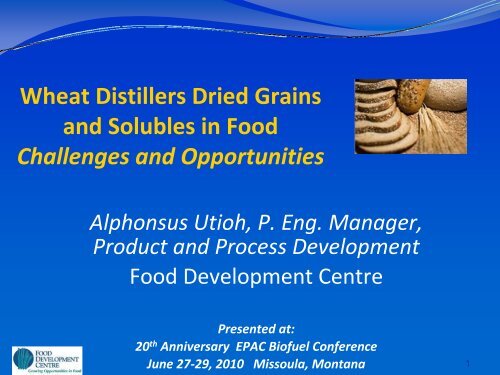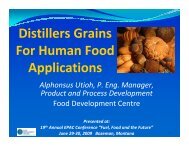Schematic of DDGS Production
Alphonsus Utioh
Alphonsus Utioh
- No tags were found...
You also want an ePaper? Increase the reach of your titles
YUMPU automatically turns print PDFs into web optimized ePapers that Google loves.
<strong>Schematic</strong> <strong>of</strong> <strong>DDGS</strong> <strong>Production</strong><br />
Wheat/Corn/Barley<br />
Fermentation CO 2<br />
Distillation<br />
Ethanol<br />
Thin Stillage<br />
Concentration<br />
Concentrated<br />
Distillers Solubles<br />
(CDS)<br />
Spray Drying<br />
Powdered<br />
Solubles<br />
Whole Stillage<br />
Decanting<br />
Drying (WDG/CDS)<br />
<strong>DDGS</strong><br />
Wet Distillers<br />
Grains (WDG)<br />
Drying<br />
Dried Distillers<br />
Grains (DDG)
Characteristics <strong>of</strong> DWG/<strong>DDGS</strong><br />
Feedstock DWG/<strong>DDGS</strong> Characteristics<br />
100% Corn • Dry granular<br />
• Orange to light brown<br />
• Fermented odour<br />
70% wheat<br />
30%Corn<br />
• Wet cake or crumbs<br />
• Orange and brown<br />
• Fermented odour<br />
100% Wheat • Dry granular<br />
• Deep dark brown<br />
• Fermented odour<br />
4
Dried Products (Wheat‐based)<br />
<strong>DDGS</strong> Air dried Drum dried Freeze dried<br />
<strong>DDGS</strong><br />
5
Chemical Analysis <strong>of</strong> <strong>DDGS</strong><br />
Cornbased<br />
Wheat/<br />
Cornbased<br />
Wheat‐based<br />
Moisture (%) 9.4 71.4 5.4<br />
Ash (%) 6.1 2.4 4.7<br />
Fat (%) 15.2 10.1 7.3<br />
Protein (%) 30.1 16.1 42.3<br />
Carbohydrate (%) 47.8 71.3 45.3<br />
Dietary Fibre<br />
31.3<br />
43.0<br />
44.4<br />
Energy (calorie/100g)<br />
449<br />
441<br />
418<br />
6
Dietary Fibre<br />
100% corn 70% CPS wheat + 30% corn<br />
100% winter wheat 100% CPS wheat<br />
50<br />
45<br />
40<br />
Total dietary fibre (%)<br />
35<br />
30<br />
25<br />
20<br />
15<br />
10<br />
5<br />
0<br />
Raw material DWG <strong>DDGS</strong><br />
7
Protein<br />
100% corn 70% CPS wheat + 30% corn<br />
100% winter wheat 100% CPS weat<br />
Protein on dry basis (%)<br />
45<br />
40<br />
35<br />
30<br />
25<br />
20<br />
15<br />
10<br />
5<br />
0<br />
Raw material DWG <strong>DDGS</strong><br />
8
Thin Stillage<br />
• Liquid part <strong>of</strong> whole stillage<br />
• Rich source <strong>of</strong> soluble protein and fibre<br />
• Generally concentrated and added back<br />
to distillers grains (<strong>DDGS</strong>)<br />
• Usual process Evaporation<br />
9
Spray Drying<br />
Before<br />
After<br />
10
Appearance<br />
•Fine, light beige powder<br />
•Low fermentation taste and smell<br />
11
Nutritional Results<br />
Characteristic<br />
(Thin Stillage Powder)<br />
Value (% db)<br />
Moisture 10.9<br />
Protein 41.5<br />
Total Dietary Fibre 21.7<br />
Fat 8.5<br />
Carbohydrates 42.5<br />
Ash 7.4<br />
Energy (Cal/100g) 368<br />
12
Properties <strong>of</strong> Commercial <strong>DDGS</strong><br />
Relevant to Food Applications<br />
• High protein<br />
• High fibre<br />
• Colour<br />
• Strong flavour and aroma<br />
• Acidic flavour<br />
• Granular<br />
13
Using DDG or <strong>DDGS</strong> in Food<br />
Product(s)<br />
Cookies<br />
(Chocolate Chip,<br />
Molasses, Spice,<br />
Sugar)<br />
Bread<br />
(White, Whole<br />
wheat, Banana,<br />
Pumpkin, Carrot‐<br />
Coconut, Sally<br />
Lund)<br />
Existing Research<br />
DDG, <strong>DDGS</strong> Amount<br />
Source<br />
Barley,<br />
Sorghum,<br />
Wheat, Corn,<br />
Rye<br />
Barley,<br />
Sorghum,<br />
Wheat, Corn,<br />
Rye<br />
Reference<br />
8 –50% Brochetti et al 1989<br />
Morad et al 1984<br />
Rasco et al 1987,<br />
1989,1990<br />
Tsen et al 1982<br />
5 – 40% Brochetti et al 1991<br />
Eidet et al 1984<br />
Morad et al 1984<br />
O’Palka 1989<br />
Rasco et al 1987<br />
Rasco & Dong 1991<br />
Tsen et al 1982, 1983<br />
14
Using DDG or <strong>DDGS</strong> in Food<br />
Existing Research<br />
Product(s)<br />
Rolls<br />
(Dinner, Nut,<br />
Cinnamon)<br />
Muffins<br />
(Corn, Oatmeal,<br />
Wheat)<br />
DDG, <strong>DDGS</strong><br />
Source<br />
Barley, Wheat,<br />
Corn, Rye<br />
Barley, Wheat,<br />
Corn, Rye<br />
Amount<br />
Reference<br />
17‐25% O’Palka 1989<br />
Rasco et al 1989<br />
15‐36%<br />
Abbot et al 1991<br />
Brochetti & Penfield<br />
1989<br />
O’Palka 1989<br />
Reddy et al 1986<br />
Pasta<br />
Wheat<br />
25–50%<br />
Maga & van Everen,<br />
1988<br />
15
Objectives <strong>of</strong> Product<br />
Development at FDC<br />
• Incorporate ethanol co‐products into a<br />
variety <strong>of</strong> food products<br />
• Identify the maximum levels<br />
• Assess the effect on the product’s<br />
sensory and nutritional properties<br />
• Optimize the product formulations<br />
16
Products with Wheat‐based <strong>DDGS</strong><br />
Product<br />
% Flour<br />
Replaced<br />
Product Quality<br />
Rye Bread 12% • Excellent sensory (taste,<br />
appearance, texture, etc.)<br />
• Achieved “high source <strong>of</strong> fibre”<br />
claim<br />
Ginger Cookie 30 ‐ 40% • Firmer, drier, crumbly and more<br />
fibrous mouthfeel<br />
• Achieved a “source <strong>of</strong> fibre” claim<br />
Nutritional Bar 63 ‐ 77% • Darker, acidic, denser and less<br />
sticky bar<br />
• Achieved “source <strong>of</strong> fibre” claim<br />
17
Products with Wheat‐based <strong>DDGS</strong><br />
Product<br />
% Flour<br />
Replaced<br />
Product Quality<br />
Peanut Butter Confection 15% • Acidic, drier, firmer and darker<br />
product<br />
• Achieved “source <strong>of</strong> fibre” claim<br />
Vegetable cracker 25 ‐ 30% • Improved sheeting quality <strong>of</strong><br />
dough<br />
• Excellent texture<br />
• Achieved a “source <strong>of</strong> fibre”<br />
claim<br />
18
Issues Affecting <strong>DDGS</strong> Use in Foods<br />
• Level <strong>of</strong> yeast cells (high nucleic acid levels)<br />
• Bacteriological quality<br />
• Metal contamination from production<br />
equipment<br />
• Antibiotic residues<br />
• Low lysine content <strong>of</strong> the protein<br />
• Other established protein and fibre sources<br />
• Feed‐grade raw material<br />
• No Regulatory approval for <strong>DDGS</strong><br />
19
Debranning<br />
• Debranning is a pre‐milling<br />
treatment which involves selective<br />
removal <strong>of</strong> the various outer layers<br />
<strong>of</strong> wheat kernel via the utilization <strong>of</strong><br />
friction and abrasion steps<br />
20
A Kernel <strong>of</strong><br />
Wheat<br />
Endosperm: 83%<br />
‐ Low in lipids, dietary<br />
fibre, minerals, high in<br />
starch<br />
Bran: 14.5%<br />
‐ Rich in dietary fibre,<br />
phytochemicals and<br />
low in starch<br />
Germ: 2.5%<br />
‐ Rich in proteins, lipids,<br />
low in carbohydrates 21
Benefits <strong>of</strong> Debranning<br />
(Abrasion)<br />
For ethanol industry:<br />
• Removal <strong>of</strong> non‐fermentable materials<br />
to improve the ethanol production<br />
efficiency<br />
• Utilization <strong>of</strong> the bran as ingredient in<br />
value‐ added food products (e.g.<br />
nutritional bars, food supplements,<br />
snack products, cereals, nutraceuticals)<br />
22
Equipment for Debranning<br />
• Satake abrasive pilot<br />
mill (Model TM‐05C)<br />
• No. 36 abrasive roller<br />
• 1mm slotted screen<br />
23
Methods<br />
Debranning<br />
time (sec)<br />
20<br />
Moisture 11.4% Moisture 13.0% Moisture 13.9%<br />
Pearled<br />
Wheat<br />
Wheat<br />
Bran<br />
Pearled<br />
Wheat<br />
Wheat<br />
Bran<br />
Pearled<br />
Wheat<br />
Wheat<br />
Bran<br />
40<br />
60<br />
•Adjusted the moisture content<br />
•Debranning and collecting samples at 20, 40 and 60 sec<br />
•Measure the weight <strong>of</strong> debranned wheat and bran<br />
•Analyzed for moisture, protein, starch, fibre, fat and ash<br />
contents <strong>of</strong> debranned wheat and bran<br />
24
Wheat Mass Removal<br />
Debranning<br />
time (sec)<br />
Moisture 11.4% Moisture 13.0% Moisture 13.9%<br />
Pearled<br />
Wheat<br />
Wheat<br />
Bran<br />
Pearled<br />
Wheat<br />
Wheat<br />
Bran<br />
• Tempering improves the rate <strong>of</strong> mass removal<br />
• First abrasion removed 4.4‐6.1% <strong>of</strong> mass<br />
• Second abrasion removed 3‐4% <strong>of</strong> mass<br />
• Third abrasion removed 3% <strong>of</strong> mass<br />
Pearled<br />
Wheat<br />
Wheat<br />
Bran<br />
20 95.6 4.4 94.4 5.6 94.0 6.1<br />
40 92.3 7.7 90.9 9.1 89.2 10.8<br />
60 89.3 10.7 87.6 12.4 86.3 13.7<br />
25
Debranning<br />
time (sec)<br />
Removal <strong>of</strong> Starch<br />
Moisture 11.4% Moisture 13.0% Moisture 13.9%<br />
Pearled<br />
Wheat<br />
0 65.4<br />
Wheat<br />
Bran<br />
Pearled<br />
Wheat<br />
Wheat<br />
Bran<br />
Pearled<br />
Wheat<br />
Wheat<br />
Bran<br />
20 71.9 11.6 67.1 18.5 65.6 17.3<br />
40 69.4 12.8 74.3 21.1 65.3 16.5<br />
60 67.0 17.8 69.4 19.9 69.3 29.0<br />
• Starch content in the bran increased with abrasion time to 29%<br />
after 60 sec<br />
• Tempering increased starch loss<br />
• Moisture and abrasion time to optimize ethanol yield and plant<br />
throughput<br />
26
Protein Removal<br />
Abrasion<br />
time(s)<br />
Moisture 11.4% Moisture 13.0% Moisture 13.9%<br />
Pearled<br />
Wheat<br />
0 13.2<br />
Wheat<br />
Bran<br />
Pearled<br />
Wheat<br />
Wheat<br />
Bran<br />
Pearled<br />
Wheat<br />
Wheat<br />
Bran<br />
20 13.0 13.4 13.1 13.6 13.0 13.7<br />
40 12.9 14.3 12.8 14.9 13.0 14.7<br />
60 12.9 15.4 13.0 15.9 12.6 16.0<br />
• Protein content <strong>of</strong> the bran increased with abrasion time<br />
• Tempering had little effect on protein removal<br />
27
Summary<br />
• Industry involvement is needed in research to<br />
facilitate the approval <strong>of</strong> <strong>DDGS</strong> in food.<br />
• New ethanol plants must involve regulatory<br />
bodies during design and construction.<br />
• More education and technical support are<br />
needed to help the food industry realize the<br />
benefits <strong>of</strong> substituting <strong>DDGS</strong> in formulations.<br />
• Debranning could improve ethanol production<br />
efficiencies while generating co‐products for<br />
use as food ingredients.<br />
28
Thank You!<br />
FOOD DEVELOPMENT CENTRE<br />
A Special Operating Agency <strong>of</strong> Manitoba Agriculture,<br />
Food and Rural Initiatives<br />
P.O. Box 1240, 810 Phillips Street<br />
Portage la Prairie, Manitoba, R1N 3J9<br />
Phone: (204) 239‐3150<br />
Toll‐free: 1‐800‐870‐1044<br />
Fax: (204) 239‐3180<br />
Email: Alphonsus.Utioh@gov.mb.ca<br />
www.gov.mb.ca/agriculture/fdc<br />
29




